
The Basics:
- For ages 11 and up (publisher suggests 13+)
- For 3 to 6 players
- Approximately 60 minutes to complete
Geek Skills:
- Active Listening & Communication
- Counting & Math
- Logical & Critical Decision Making
- Reading & Writing
- Memorization & Pattern/Color Matching
- Strategy & Tactics
- Risk vs. Reward
- Hand/Resource Management
- Bluffing and Misdirection
Learning Curve:
- Child – Moderate
- Adult – Easy
Theme & Narrative:
- When the hunter becomes the hunted, no one is safe
Endorsements:
- Gamer Geek approved!
- Parent Geek approved!
- Child Geek mixed!
Overview
The elders of the village took no risks. They hired as many bounty hunters as they could and told them where the monster could be found. At sunset, the bounty hunters walked into the monster’s abandoned mansion. Somewhere in this building was their prey. Unknown to the bounty hunters, the monster they sought was standing among them and eager to hunt, as well.
Hunt: The Unknown Quarry, designed by Jeremy Lennert and published by Victory Point Games, is comprised of 3 Mansion game boards (double-sided), 50 cards, 6 Player screens, 9 Note sheets, 6 Player pawns, 6 Pawn stands, and 1 standard six-sided die. The game boards and player screens are made of thick cardstock, the Player pawns are made of thick cardboard, and the Pawns stands are made of plastic. The illustrations by Clark Miller capture the decor and grandness of the mansion, as well as the personalities who hunt within it. It’s worth mentioning that the game only comes with 9 Note sheets, but the back of the rule book can easily be copied and printed to produce more. Victory Point Games has given permission to the game owner to do so. Not included in the game, but necessary to play, is a pen or pencil for each player.
Arriving at the Mansion
To set up the game, first place the 3 Mansion game boards in the middle of the playing area. You will need a large enough space to accommodate 3 11″ x 17″ game boards. Each game board represents a specific floor of the house (upstairs, ground floor, and basement) and each is double-sided. Players can decide which side they want to use, changing the layout of the Mansion each time they play the game.
Second, each player selects 1 Note sheet, 1 Player pawn, 1 Pawn stand, 1 matching Player screen and 1 matching Energy card (the Energy card, Player Screen, and Player pawn will have the same character on it). The Player pawn is placed in the “Hall” of the ground floor, the Player screen is placed in front of the player, the Note sheet is placed behind the Player screen, and the Energy card is placed in front of the Player screen, visible to all players. Make certain the Energy card is placed to the side that says “Exhausted” is face-down. Place any Player pawns, Player screens, and Energy cards not used back in the game box.
Third, separate the cards into 3 piles. When done, there will be 1 pile of Standard actions, 1 pile of Monstrous Abilities, and 1 pile of Items. Shuffle each pile separately.
Fourth, take the Monstrous Abilities and deal 2 face-down. Place the remaining Monstrous Abilities aside for the moment and pick up the Items. Create additional piles of 2 Item cards each so the total number of piles (including the Monstrous Abilities) equals the number of players. For example, in a 4-player game, you would have 1 pile of 2 face-down Monstrous Abilities and 3 face-down piles of 2 Item cards each. Place the undealt Items on top of the Monstrous Ability cards and shuffle, taking care not to see the Monstrous Ability cards. Place this deck of cards face-down and to one side of the game board for the moment.
Fifth, the players take turns rearranging the location of piles without changing the cards in each pile. While 1 player re-arranges the order of the piles, the other players look away. This is repeated until all players have had a chance to re-arrange the order. This ensures that all players, including the dealer, have no idea which pile contains which cards.
Sixth, each player selects a pile of cards and looks at them, taking care not to show them to their opponents. If the player only has Item cards, they are a “Human”. If the player has Monstrous Ability cards, they are the “Monster”. Players should keep their identity hidden at all times.
Seventh, take the deck of cards that contain the Items and the rest of the Monstrous Abilities and deal cards to each room in the Mansion. Each room will have a number value. This number value indicates the number of face-down cards that are dealt to it. When done, divide any remaining cards between the rooms with an asterisk as evenly as possible.
That’s it for game set up. Determine who will begin the hunt and give them the Standard Action cards.
On Being a Hunter
A bounty hunter is only successful if they know what they hunt and have the right equipment to get the job done. The popular notion is that bounty hunters kick open doors and fire at anything that moves. This could not be any further from the truth. The prey hunted by the bounty hunter must first be understood and scrutinized for weaknesses. Then, and only then, will the bounty hunter have the edge they need to be successful.
Standard Action Cards
The Standard Action cards represent those actions that can be taken by both “Human” and “Monster” on their turn. Item and Monsters Ability cards can be used instead, but revealing any card other than the Standard Action card gives away information. As such, players will find themselves using the Standard Actions during the game to not only hide what they know, but also to reveal more information.
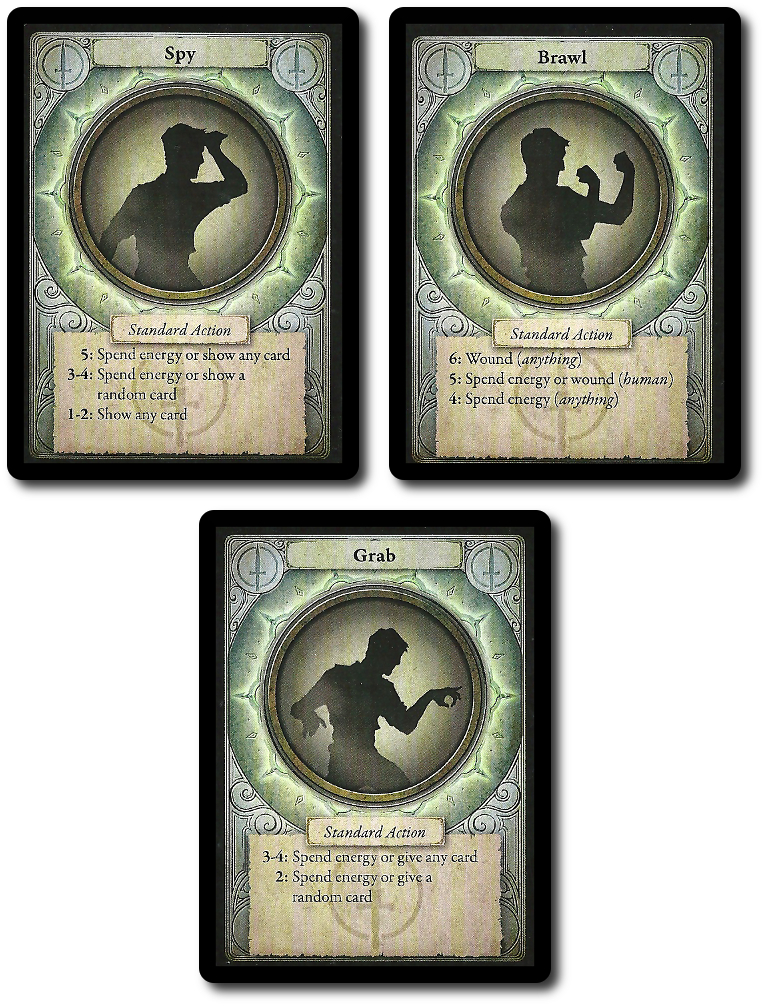
Item Cards
Item cards depict the various pieces of equipment, weapons, and armor the bounty hunter may use to hunt their prey. Item cards are also known as Action cards, since they allow the player to take an action beyond the Standard Action cards. Each Item card identities which monster type it can be used against and a short list of random outcomes. A bounty hunter will make use of several different Item cards during their time in the Mansion, as they attempt to learn what weapons are the most effective of damaging the mysterious monster and what armor will keep the bounty hunter alive. Item cards can also be used as reactions, allowing the player to duck and dodge. Unfortunately for the bounty hunters, the monster can use Item cards, as well.
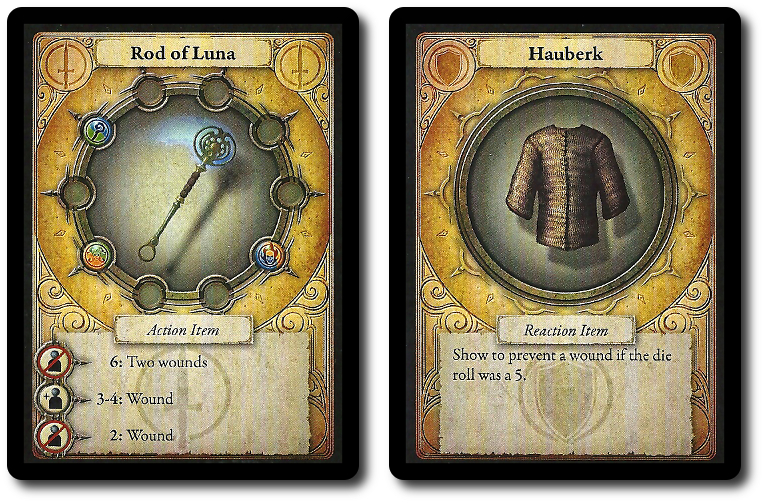
Monstrous Abilities
Monstrous Ability cards are like Item cards, except they are only used by the “Monster” player. They always target “Humans” and are played in the same fashion as Item cards. However, Monstrous Ability cards reveal that the player is the monster and should not be used unless absolutely necessary.
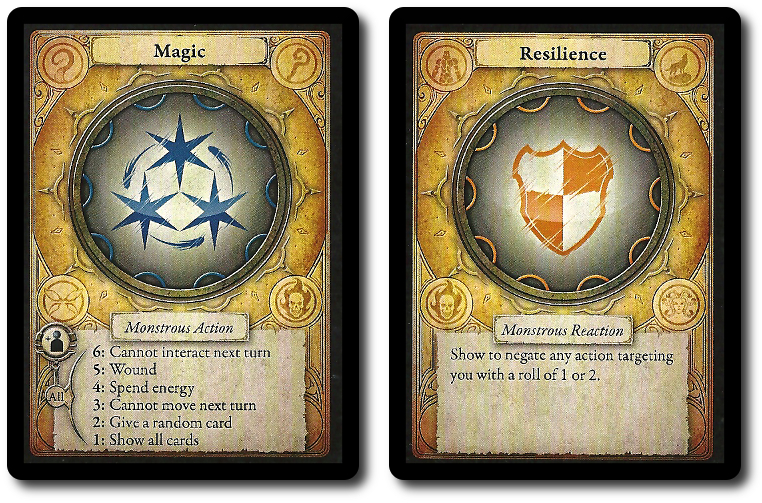
These two Monstrous Ability cards indicate that the player is a “Lich”
In addition, the Monster Ability cards the player possesses determine what monster type they are (Golem, Warlock, Naga, Gorgon, Spirit, Werewolf, Lich, Revenant, Vampire, and Fairy). Technically, “Human” is a monster type, too, since players are not on a team. Each player should take special note of their monster type so they know which Item cards hurt them.
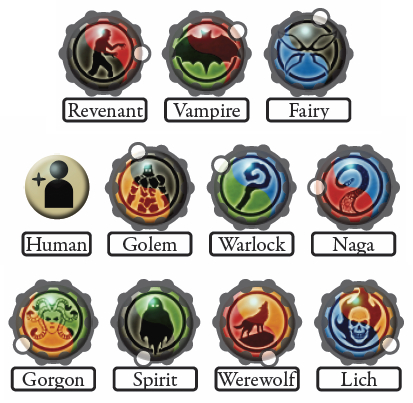
Note Sheet
The Note sheet is an invaluable tool for both the “Human” and the “Monster”. Safely behind the Player screen, the player can take notes about what they find and who they think the players are. Hidden about the Mansion are clues to be discovered and each encounter with another player will reveal a small bit of additional information about their true motives. The Note sheet also serves as a way to keep track of health and card locations in the Mansion.

Hunter/Hunted
Hunt: The Unknown Quarry is played in turns with no set number of turns per game. On a player’s turn, regardless if they are a “Human” or the “Monster”, they will take a specific number of actions. At the start of the game, the first player can only take 1 action, the second player can take 2 actions, and the third player can take 3 actions. From them on, all players can take up to 4 actions. Note that a player is never forced to take all of their actions and they can take the same action multiple times, but each individual action must be resolved first before taking another one.
Step 1: Take Actions
Move
Movement in the Mansion is done by taking the Player pawn and moving it to an adjacent room for 1 action. The rooms must be connected via a doorway (the players cannot pass through walls). Each floor also has stairs. For 1 action, the player can move their Player pawn from the room on the currently occupied floor to the adjoining room above or below (depending on where the stairs go).
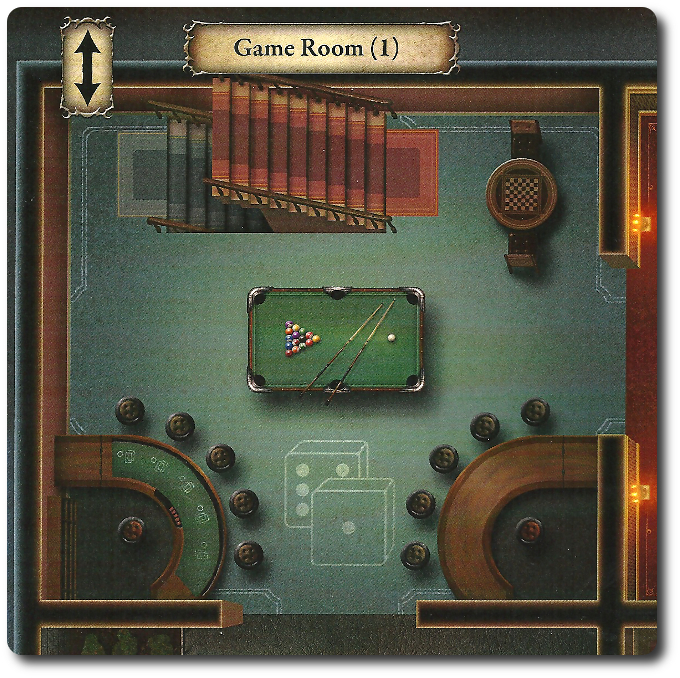
Players are penalized by harassing opponents and must spend an extra action to move for every opponent who is making movement difficult. This penalty is in addition the the normal movement action cost.
Search
This action allows the player to take all the face-down cards located in the same room as their Player pawn and look through them. The player should look through cards as privately as possible and take any notes they think necessary. When done, they place them back to the room, face-down.
Pick Up
This action allows the player to take all the face-down cards located in the same room as their Player pawn and take 1 card to add to their hand, put only if their previous action was searching the room. A player cannot have anymore than 4 cards. If the new card would increase the hand size beyond 4, the player must drop 1 card in the room, adding it with the other cards located in the location, face-down.
Players can never take Monstrous Ability cards they might find (but they certainly should note it on their sheet) and they can never drop Monstrous Ability cards. This action can be taken several times, but it costs 1 action to take each card.
Interact
For the players’ first 2 turns, all they can do is look around the Mansion, take notes, search, and find items. After that, they can get a little more “friendly” with their opponents. When the player’s pawn is in the same room as an opponent’s pawn, they can point to the owning player and announce they are interacting. They then select 1 card from their hand, which can be any of the Standard Action cards or any Item card or Monstrous Ability card (if the player is the “Monster”). The only requirements is that the card must have the keyword “Action” listed on its face. The selected card should be held by the player and the rest of their cards are set aside. The selected card is not shown to the player’s opponents at this time.
The player then rolls the six-sided die and compares the value with the list of outcomes on the card. If the player is happy with the result, they pass their card to the target so that none of the other opponents can see it. The target reviews the card and the die value rolled, taking any notes as necessary. If the player is not happy with the results, they keep their card hidden with no effect.
Regardless of the outcome, the target of the player’s interaction is now “harassed” and suffers a penalty to their movement for as long as the target and the player occupy the same room.
Actions and Energy
The primary actions are listed above, but the player can spend Energy to augment effects. Each Energy card is double-sided. When the game begins, each character is refreshed and ready for the hunt. By tipping the Energy card sideways, the player can use 1 Energy. If the player uses another Energy while the Energy card is already tipped, it becomes “Exhausted” and is flipped over, indicating that the player can no longer use Energy, even if the actions they are using say to do so.
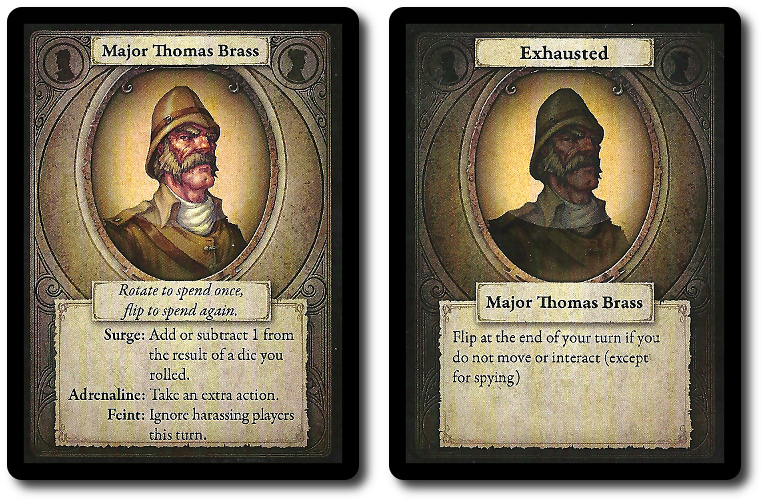
In all cases, a player can use their Energy to add or subtract results from the die (referred to as a “Surge”), obtain an additional action beyond the normal 4 (referred to as “Adrenaline”), and ignore the effects of being harassed (referred to as a “Feint”).
In additional, some actions that target the player will give them the option of spending Energy to reduce, completely avoid the effects listed, or force Energy to be drained.
Step 2: Recover Energy
The player regains their Energy at the end of their turn, but only if the only actions taken were from the Standard Action cards. Movement or any interaction with opponents, including the use of other Item or Monstrous Ability cards, stops the players from resetting their Energy card. It’s important to note that a player that doesn’t have Energy to spend is not penalized. The biggest risk they run is simply not being able to take advantage of the benefits that come from having Energy available.
This ends the player’s turn. The Standard Action cards are handed to the next player in turn order sequence.
Creatures and Combat
Hunt: The Unknown Quarry is more than just a game of searching and exploring. It’s also a game of hide and seek, where the hunter is also being hunted. Eventually, players will get to a point where they think they need to test some of their theories to determine if the opponent next to them is human or something else. This is done by interacting with the opponent and using an action.
Not all actions target all monster types and not all actions are safe to use against humans. This means a player might get a false positive when they use an action against an opponent or learn a great deal more than they bargained for. It’s also possible that the player might end up hurting a “Human” rather than hurting the “Monster”, which is exactly what the monster wants.
Each Item and Monstrous Ability cards lists the monster types that can be targeted using the card. It will also list if the card’s effects will target a “Human” or not. Effects include forcing the opponent to share information, giving cards, and spending energy. It can also result in dealing a wound.
Wounds are recorded on the player’s Note sheet and kept secret. “Human” players become crippled after they take 3 wounds. While not out of the game, a crippled player is not able to fully function. Energy cannot be spent, movement is restricted, and it’s harder to interact. In short, the player’s character is dragging themselves around the Mansion, broken, bruised, and most likely pissed off. They can still kill the monster if they can catch it. Epic.
The “Monster” player is mortally wounded when they take damage equal to the number of players (including themselves). If the monster is mortally wounded, but all the bounty hunters are crippled, the “Monster” player is able to escape. However, if even just 1 bounty hunter is still healthy, the monster has breathed its last.
A Successful Hunt
The game has two possible outcomes.
If the “Monster” is destroyed, the player who delivered the mortal blow is the winner. All the other surviving “Human” bounty hunters are left disappointed, but can rejoice in the fact they did not become the monster’s victim.
If the “Monster” player is able to cripple all of the “Human” bounty hunters, then the monster is free to leave. The identify of the monster will remain a secret, allowing it to continue its nefarious deeds.
To learn more about Hunt: The Unknown Quarry, visit the game’s web page.
Final Word
This was a fun game for the Child Geeks, but only those who were more experienced and older. The rules to the game are simple, but it can be difficult to use those rules to navigate the game play. Specifically, finding information. According to one Child Geek, “I understand the game, but I don’t really know what to do with the information I am provided.” Specifically, it was what the Child Geeks’ learned, or didn’t learn, that kept tripping them up. Another Child Geek said, “If you keep track of everything you find on the paper and watch how other players interact, you can learn a lot.” Yes, you certainly can, but that is also hard to do. Especially when you are a Child Geek who is getting frustrated and bored. The final result was a game playing experience that only our more experienced Child Geeks enjoyed, giving Hunt: The Unknown Quarry a mixed level of approval.
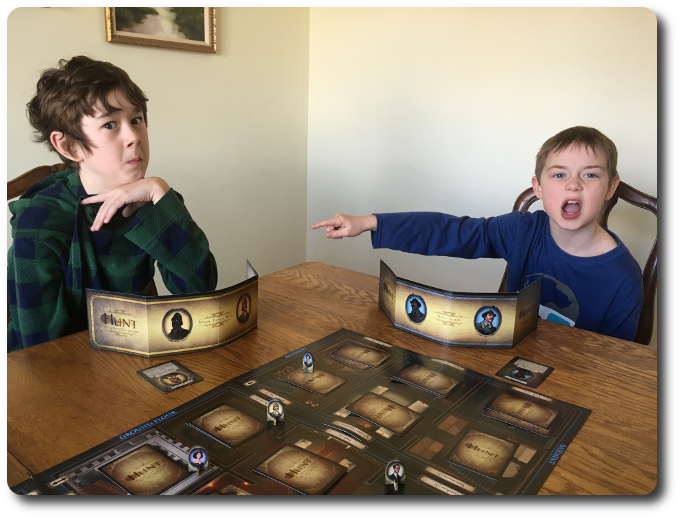
Accusing others of being a monster is not only common, but also potentially damaging to the wrong party…
The Parent Geeks really enjoyed themselves, finding the game to be moody and exciting, mixed with clever deduction and surprises. According to one Parent Geek, “This is my new favorite mystery game. I love how you have to tinker and search, discover and deduce. Lots of fun.” Another Parent Geek said, “The complexity of this game is mostly in the your head. Everything you need is right in front of you, but you have to piece it together. I really like that.” Another aspect of the game the player’s liked was how nothing was a given. Each time a player learned something new, it opened up new possibilities and called others into question. Nothing was for certain until that moment when the player attacked another and found out the horrible truth. All the Parent Geeks voted to approve Hunt: The Unknown Quarry.
The Gamer Geeks were also impressed. According to one Gamer Geek, “What sets this game apart is that it’s not a cooperative exercise. If it was, the monster would be at a serious disadvantage. As it’s designed, even players technically on the same side are not on the same team, making it easy for the monster to play people against each other.” Another Gamer Geek said, “I like how players have to work for it. This is not a game that gives you information just becomes you took a certain card. You have to use that card, determine the results, and then decide what to make of it.” If there was one thing the Gamer Geeks liked most of all it was the challenge the game provided. All of their games had surprising twists and memorable moments. All the Gamer Geeks voted to approve Hunt: The Unknown Quarry.
Hunt: The Unknown Quarry is a mix of Clue, Werewolf, and Battlestar Galactica. Social deduction, critical thinking, and bluffing are all integral parts of the game play. Everyone knows that one member of their party is the prey, but in many respects, everyone is being hunted. This is due to the game being semi-cooperative. Only 1 player can win, so it’s not in a “Human” player’s best interest to reveal the monster until they are the last one standing. Likewise, a “Monster” player needs to keep hidden and cast as much doubt and suspicion as possible. The key to this game is collecting as much knowledge as you can and giving away nothing in return.
But knowledge is not enough. Or, better put, it’s just half of the puzzle. A player must act, as well. Some actions are meant to obtain knowledge while others are meant to exploit it. How a player goes about such actions needs to be carefully thought out. Again and again, each player’s turn is observed and scrutinized by their opponents and supposed friends. In many respects, what actions and opponents a player avoids is just as important as the actions they take and the opponents they hunt.
Everything a player does puts them at risk and in the spotlight. Even what they don’t do tells their opponents a great deal. This makes the game feel a bit slow at times because players can very easily over think things and begin to suffer from mental vapor lock. For example, a Gamer Geek took about 3 minutes to just look at 2 cards from a room. Another good example is a player considering if they should go upstairs or downstairs. It might seem silly, but when you are in the game, each turn is an opportunity to obtain a huge advantage and the growing fear that you are being left behind is a serious motivator.
Hunt: The Unknown Quarry is one of those games that will leave you with memories and stories to share. It will fill the player with temptation to bend the truth, test their ability to trust others, and will quickly have them questioning everything and everyone. It’s brilliant. If you enjoy games where there is a traitor among you, what you know is just as important as what you don’t know, and the only thing for certain is how to win, then do play Hunt: The Unknown Quarry.
This game was given to Father Geek as a review copy. Father Geek was not paid, bribed, wined, dined, or threatened in vain hopes of influencing this review. Such is the statuesque and legendary integrity of Father Geek.



